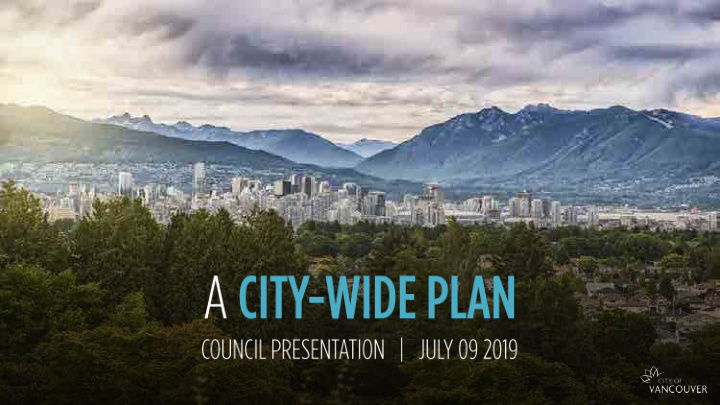



Engaged community and delivered “Directions” for the future Developed some detailed policy “chapters” as a second phase (not all completed) “ Neighbourhood Visions” process ensued
Climate change Population growth Continued pressures on affordability and diversity Immigration, aging and other demographic changes Major economic shifts Possible public health and system stresses Continued pressures on delivery of public services
Healthy? Diverse and inclusive? Prosperous – with shared prosperity? Resilient to shocks and stresses? Environmentally sustainable? Joyful and sociable? Culturally rich? Capable of continued adaptation and innovation? With an accessible, responsive local government?
The question is not whether Vancouver will be transformed, but rather: Will we… How will we… & How well will we... guide that transformation and create a desired future for ourselves and future generations?
Backcast from desired future to now – to define choices and big moves. Revisit assumptions. Dream big. Explore. Do better with what we know how to do.
Values, issues, concerns + Current conditions aspirations Long term trends What kind of city do we want to be in 30 - 50 years?
Empathy Trust Equity Reconciliation Resilience Learning
PROVINCIALLY DELEGATED AUTHORITY Vancouver Charter & Local Government Act THE REGION Regional Growth Strategy FUTURE CITY-WIDE PLAN CITY-WIDE STRATEGIES AREA PLANS Official Neighbourhood/ Policy Development District Statements Plans Plans 41
Council Council & Staff Staff Financial Strategies, City-wide Service Priorities Goals Strategies 5 year Plan Plans Plans and Budgets
Robust and diverse engagement leading to: Values Issues Aspirations Principles Engagement Plan Update Report to Council: Q2 2020 Conditions + Trends Report
• Co-create Plan with Musqueam, Squamish + Tsleil-Waututh Nations • Include Urban Indigenous communities Examples: • Hiring Indigenous Planners • Identifying opportunities to advance reconciliation
• As people are accessing services, shopping, socializing • Approach groups that already convene Examples: • Mobile community office • Tables at community centres, neighbourhood houses, libraries • Presence at events, celebrations, neighbourhood gathering places
• Multiple avenues for providing input and involvement • Variety of media to share information Examples: • Workshops + drop-in events • Neighbourhood walking tours • Digital submissions (eg. video) • Surveys + questionnaires
• Enjoyable, rewarding, and relatable to diverse groups • Simple, clear, and visually accessible materials and activities Examples: • Youth-focused engagement • Work with local artists + orgs • Open-ended engagement questions
• Partner with organizations host engagements and conversations • Tools and resources to capture community knowledge Examples: • Dialogue circle discussion guides and tool library • Training for community facilitators • Volunteer and ambassador opportunities
• Address barriers that prevent many groups from participating • Tailor approaches, resources, and materials to support broader representation Examples: • Robust translation resources • Funds to provide childminding, food, and other supports • Tailored outreach strategies for under- represented groups
Vancouver’s 120 five -minute catchments. (Source: TheTyee.ca, Hein & Hardwick, Oct.17, 2018)
To remain in effect until City-wide Plan directions are established Updates to policy will be considered to align with vision Concurrent planning programs (eg. Broadway Plan + Jericho Lands) will be coordinated and connected
Manage Process Outreach Barrier Reducing Outreach Values, Issues + Principles Drafting Policy Options Policy Testing Review of Strategic Directions Drafting the Plan Review of Draft Plan Plan Approval The Community Community Groups + Non-Profits City/Regional Stakeholders City Staff Team Council Advisory Committees City Boards + Agencies Musqueam, Squamish + Tsleil- To be confirmed through government- Waututh (Staff + Council) to-government meetings v v v City of Vancouver Council
• Assemble a robust interdepartmental team • Redeployment of existing staff and some new • Integrated project team office Engagement resources reflecting scale of effort • • Support First Nations partnership • Supports/grants for equitable engagement • Mobile community office • Multiple in-person and online tools Technical modelling + future scenarios • Assess options and trade-offs with public •
• Getting started with 2019 funds available (3.4M) • Annual budget decisions by Council 2020 – 2022 (estimate ~ 4.8M average /year)
A. General planning and engagement process B. Involvement of all relevant departments C. Rigorous and deep consultation process D. Further development of program and budget for 2020-22 E. Report back at key milestones F. Report be referred for information to affected and partner governments, boards and authorities
Recommend
More recommend